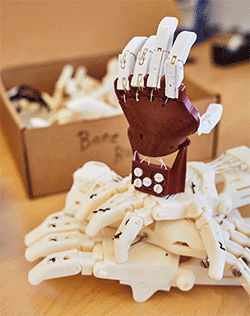The World Acting Globally
A Thousand Aha Moments
SPU Engineering Students Invent “The Falcon Hand”
By Jeffrey Overstreet (jeffreyo@spu.edu) | Photos by Garland Cary
 Last summer, Dr.
Adam Arabian (right) and
his team: (left to right)
Sean Russell, Barrett
Estep, Perris Anawati
designed and printed
prosthetics. This summer,
student interns will build
more 3-D printers to
produce class designs.
Last summer, Dr.
Adam Arabian (right) and
his team: (left to right)
Sean Russell, Barrett
Estep, Perris Anawati
designed and printed
prosthetics. This summer,
student interns will build
more 3-D printers to
produce class designs.
![]() View more photos
View more photos
In Autumn 2014, Seattle Pacific University Assistant Professor of Mechanical Engineering Adam Arabian struck up a conversation online with David Levin of Refugee Open Ware, an organization developing innovative solutions for refugees, in Amman, Jordan. Levin was investigating cutting-edge prosthetics to help some of the 200,000 amputees among refugees from the Syrian war — specifically, amputees living in Syria’s Za’atari refugee camp.
In Za’atari, 25 percent of amputees are upper-limb amputees, so a practical prosthetic hand could benefit many people. Arabian set a group of his engineering students to the task of designing and producing, with the engineering lab’s new 3-D printers, prosthetic hands that would meet this need.
“If people love our design, they can take it. They can even steal it. So long as we solve the problem.”
“We’ve seen a lot of passion for prosthetics in the maker community,” he says, referring to a growing global network of people who share ideas and designs for 3-D-printed objects. “We saw an opportunity to apply engineering principles to make better solutions.”
Arabian and his team of students — sophomore Barrett Estep and seniors Perris Anawati, Nick Rogers, and Sean Russell — started with an open-source hand design from a group called E-Nable, but found it too bulky. “The Falcon Hand” is designed to suit the needs of adults in Za’atari: It’s smaller, sculpted to look like a real hand, and it has a repositionable thumb that enables wearers to use a variety of grasp patterns.
And what happens if it breaks? “It’s like working with Legos,” says Estep. “If you break it, you can fix it yourself” — even one-handed.
Both Estep and Russell know something about Legos. “Fifty percent of my childhood time? Legos,” says Estep.
“I started in the exact same place,” says Russell. “Whenever I saw a mechanical device, I wanted to take it apart and figure out why it worked. When I got here, it’s like I got the best Lego set ever.“
Their teamwork is a constant process of 3-D-printing trial and error. “This,” says Arabian, holding up a box full of loose plastic pieces, “is ‘The Boneyard.’ These are all of the ideas that didn’t work.”

“Our hands,” says Estep, “are the result of a thousand little aha moments.”
The team is still testing their design, which is several steps away from being used by amputees. Meanwhile, innovations are in the works. Russell is fashioning a slider switch that allows the user to secure a grip. As they share their prototypes online (at a place called Thingiverse, which Estep calls “YouTube for 3-D printers”), their goal is that people who need these hands will be able to produce them anywhere that a 3-D printer is available.
Printing new prosthetics right in the lab is exciting, says Estep. But even more exciting is the prospect of changing lives on the other side of the world.
“The point of our project has never been for us to achieve the next big design,” says Arabian. “The point has been to say, ‘We’ve got great ideas. Let’s try them. If people love our design, they can take it. They can even steal it. So long as we solve the problem.’”
